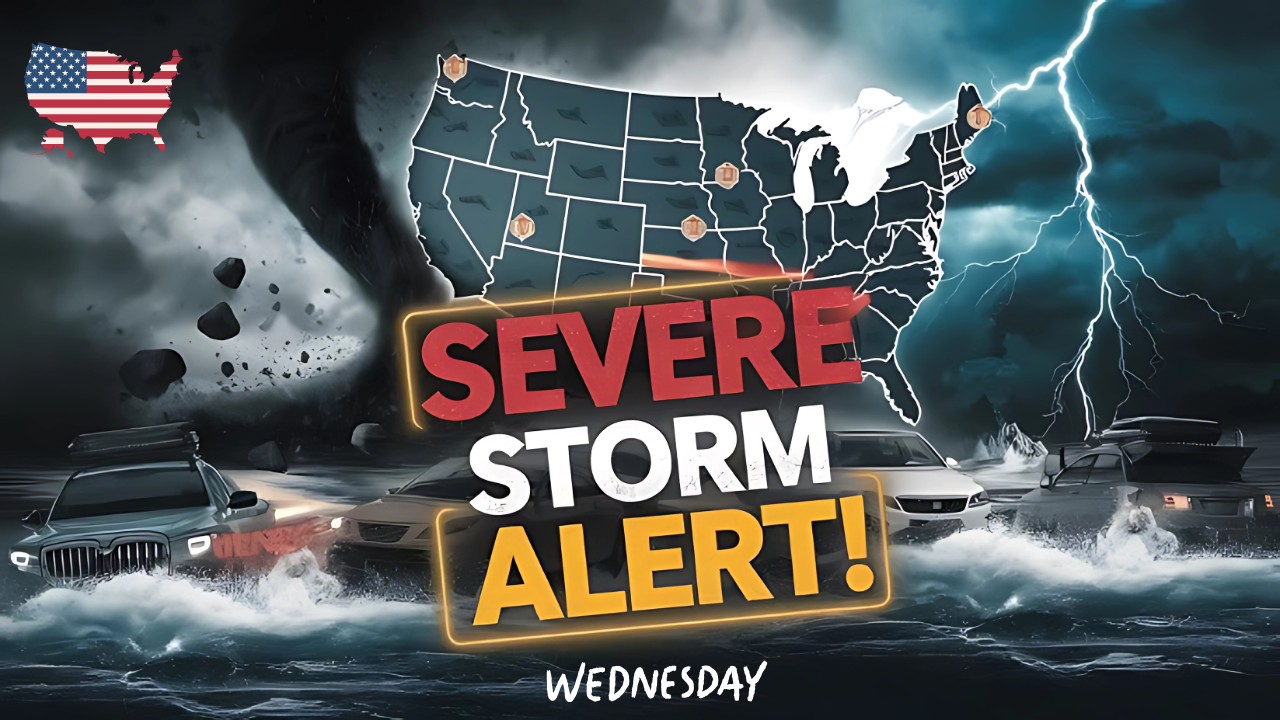Las Vegas residents woke up to an unexpected sight this Monday morning – raindrops dotting their windshields and the sweet smell of petrichor filling the typically arid desert air. As someone who’s lived through countless scorching summers in Sin City, I can tell you that any relief from the relentless heat feels like a small miracle, even if it comes with its own set of challenges. Las Vegas Weather faces scattered showers and storms through Wednesday as Tropical Storm Alvin remnants bring rare desert rainfall before triple-digit heat returns.
Current Las Vegas Weather Situation Unfolds Across Southern Nevada

The early morning hours brought light rainfall and scattered showers across eastern and southern portions of Clark County, creating quite the spectacle for early commuters and joggers. This unusual weather pattern stems from the remnants of Tropical Storm Alvin, which has been tracking eastward across the region, leaving behind a trail of moisture that our desert landscape rarely experiences during the summer months.
Local meteorologists have been closely monitoring this system since the weekend, and their predictions are proving accurate. The storm’s remnants have created a perfect setup for scattered precipitation that’s expected to linger through Wednesday, giving residents a brief respite from what would otherwise be typical June weather.
Understanding the Storm’s Path and Impact
The meteorological setup creating these conditions is actually quite fascinating from a scientific standpoint. Tropical Storm Alvin, which originally formed over Pacific waters, has maintained enough moisture content to influence weather patterns even as it moves inland. This isn’t entirely uncommon for our region, but it’s certainly noteworthy enough to warrant attention from weather enthusiasts and casual observers alike.
The storm’s track has brought it directly through areas that typically see very little precipitation during the summer months. For context, Las Vegas averages less than half an inch of rainfall during the entire month of June, making any meaningful precipitation a significant departure from normal patterns.
Detailed Day-by-Day Forecast Breakdown
Monday’s Weather Reality Check
As Monday progresses, residents can expect the scattered showers to gradually taper off during the evening hours. However, don’t let the presence of clouds fool you into thinking it’ll be a cool day. Afternoon temperatures are still climbing to around 94 degrees Fahrenheit, and with the added moisture in the air, it’s going to feel considerably more humid than usual.
The muggy conditions are something Las Vegans rarely experience, and it can catch people off guard. That sticky feeling you might notice stepping outside? That’s humidity levels significantly higher than our typical bone-dry desert air. It’s almost like getting a taste of what summer feels like in places like Houston or Miami, though thankfully much more temporary.
Wind conditions throughout Monday will remain notably breezy, with sustained winds and gusts ranging between 15 and 25 miles per hour. These winds are actually helping to move the storm system along, but they’re also creating interesting dynamics with the shower activity.
Tuesday’s Transitional Weather Pattern
Tuesday morning will greet early risers with relatively mild conditions, as overnight lows settle into the upper 70s. For many Las Vegas residents, this represents some of the most comfortable sleeping weather they’ll experience all summer. Windows that have been sealed shut since April might actually get opened for some natural air circulation.
The real story for Tuesday revolves around an approaching low-pressure system that’s making its way inland from the California coast. This system is expected to maintain the slight chance of showers in our forecast, particularly during the afternoon and evening hours. Meteorologists are keeping a close eye on this development because it represents the continuation of our unusual weather pattern.
What makes Tuesday particularly interesting is that it brings the highest potential for additional precipitation, especially across the higher elevations surrounding the Las Vegas Valley. Areas like Mount Charleston, Red Rock Canyon, and the Spring Mountains could see more substantial rainfall amounts compared to the valley floor.
Wednesday’s Weather Finale
Wednesday represents the final day of this weather pattern before things begin shifting back toward more typical desert conditions. The low-pressure system will still be influencing our weather, but its effects will be gradually diminishing as high pressure begins building back into the region.
For outdoor enthusiasts and those with Wednesday evening plans, this could actually be ideal timing. The combination of slightly cooler temperatures and the possibility of light showers creates conditions that many desert residents find refreshing and invigorating.
Regional Impact Analysis Across Clark County
Valley Floor vs. Elevated Areas
The geographic diversity of Clark County means that this weather system affects different areas quite differently. While the Las Vegas Strip and downtown areas are experiencing light showers and slightly cooler conditions, the mountainous regions surrounding our valley are seeing more significant impacts.
Higher elevation communities like Mount Charleston are receiving notably more precipitation, which is excellent news for fire safety concerns and overall ecosystem health. These areas often serve as critical watersheds for our region, and any additional moisture helps recharge groundwater supplies and supports local vegetation.
The temperature differential between valley floor and elevated areas becomes even more pronounced during weather patterns like this. While we’re seeing mid-90s temperatures in the valley, areas just a few thousand feet higher are experiencing temperatures in the 70s and 80s, creating dramatically different comfort levels within the same county.
Transportation and Commuter Considerations
Las Vegas drivers aren’t particularly experienced with wet road conditions, especially during the summer months. Monday morning’s rainfall created typical challenges that locals face whenever precipitation occurs: slick roads, reduced visibility, and drivers who haven’t adjusted their driving habits for wet conditions.
The Nevada Department of Transportation has been monitoring road conditions closely, particularly on elevated roadways and mountain passes where precipitation tends to be heavier. While no major incidents have been reported, transportation officials always encourage extra caution during these relatively rare weather events.
Airport operations at Harry Reid International Airport have continued normally, though travelers should always check with their airlines for any potential weather-related delays. The scattered nature of the showers means that impact on air travel has been minimal, but it’s always wise to stay informed.
Historical Context and Seasonal Perspective
How Unusual Is This Weather Pattern?
To put this weather event in proper perspective, it’s worth examining how unusual these conditions really are for early June in Las Vegas. Historically, our monsoon season doesn’t typically begin until mid to late July, making this early-season moisture somewhat of an anomaly.
Weather records show that significant precipitation events during the first week of June occur roughly once every seven to ten years in our region. This doesn’t make the current situation unprecedented, but it does classify it as noteworthy for meteorological record-keeping purposes.
Long-time residents often remember similar events from decades past, and there’s something almost nostalgic about experiencing weather that reminds us of spring rather than the relentless summer heat that typically dominates this time of year.
Climate Patterns and Larger Trends
The broader meteorological picture that’s creating these conditions ties into larger Pacific weather patterns that influence our entire region. El Niño and La Niña cycles, while not directly causing this specific event, create background conditions that can make unusual weather patterns more or less likely.
Current ocean temperature patterns and jet stream positioning have created a setup that allows moisture from tropical systems to penetrate further inland than usual. This isn’t necessarily indicative of long-term climate changes, but it does demonstrate the complex interconnectedness of weather systems across vast geographic areas.
The Return to Summer Reality
Thursday’s Weather Shift
By Thursday, meteorologists expect a significant shift in our weather pattern as a ridge of high pressure begins rebuilding across the southwestern United States. This development will effectively shut off the moisture tap that’s been providing our recent precipitation and will begin pushing temperatures back toward more typical summer levels.
The transition back to high-pressure dominance means that the brief reprieve from extreme heat will be short-lived. Weather models are already indicating that triple-digit temperatures will likely return by the weekend, marking the end of this unusual weather interlude.
Weekend and Beyond Temperature Outlook
As we move into the weekend and beyond, Las Vegas will likely experience temperatures climbing back above seasonal norms. This means we’re looking at potential high temperatures reaching 105-110 degrees Fahrenheit, which represents a dramatic shift from the current mid-90s readings.
The psychological impact of this temperature swing can be significant for residents who have enjoyed a few days of more moderate conditions. It serves as a reminder that summer in the desert is just getting started, and the hottest months typically lie ahead.
Residents are encouraged to use this brief cool period to prepare for the return of extreme heat: checking air conditioning systems, stocking up on water, and planning outdoor activities for early morning or late evening hours when temperatures are more manageable.
Safety Considerations and Practical Advice
Driving in Desert Rain Conditions
For many Las Vegas residents, driving in wet conditions feels almost foreign due to our typically dry climate. When rain does occur, especially after extended dry periods, road surfaces can become particularly slick as oil and debris create hazardous conditions.
Local traffic authorities recommend reducing speed, increasing following distances, and avoiding sudden acceleration or braking when roads are wet. The combination of infrequent rain and drivers unaccustomed to wet conditions can create challenging situations on our roadways.
Outdoor Activity Adjustments
This weather pattern actually creates some unique opportunities for outdoor enthusiasts who typically avoid daytime activities during summer months. The combination of slightly cooler temperatures and increased humidity can make hiking and other outdoor pursuits more comfortable than usual for this time of year.
However, it’s important to remember that desert weather can change rapidly, and afternoon thunderstorms can develop quickly when atmospheric conditions are unstable. Anyone planning outdoor activities should monitor weather conditions closely and be prepared for sudden changes.
Economic and Tourism Implications
Impact on Local Tourism Industry
Las Vegas tourism during summer months typically revolves around indoor activities, pools, and evening entertainment due to extreme daytime heat. This brief period of more moderate weather actually provides some additional options for visitors who might want to explore outdoor attractions.
Popular destinations like Red Rock Canyon, Valley of Fire, and Lake Mead become more accessible during periods of moderate temperatures, potentially providing economic benefits for tour operators and outdoor recreation businesses that typically see reduced demand during peak summer months.
Agricultural and Landscaping Benefits
While Las Vegas isn’t known for agriculture, the surrounding region does support various farming operations that benefit significantly from any natural precipitation. Additionally, residential and commercial landscaping throughout the valley receives welcome relief from irrigation demands during periods of natural moisture.
Local water authorities note that any reduction in irrigation needs, even temporary, helps conserve water resources during peak summer demand periods. This is particularly important given ongoing regional water conservation efforts and drought conditions affecting the Colorado River system.
Faqs Las Vegas Weather
Will this weather pattern continue through the summer?
No, this is a temporary pattern expected to end by Thursday as high pressure rebuilds across the region.
Is this normal weather for early June in Las Vegas?
While not unprecedented, significant precipitation in early June occurs roughly once every seven to ten years in Las Vegas.
Should I be concerned about flooding or severe weather?
Current conditions pose minimal flooding risk, but always exercise caution when driving on wet roads and avoid low-lying areas during heavy downpours.
Weather Data Reference Table
| Day | High Temp | Low Temp | Precipitation Chance | Wind Speed |
|---|---|---|---|---|
| Monday | 94°F | 78°F | 40% | 15-25 MPH |
| Tuesday | 96°F | 79°F | 30% | 10-20 MPH |
| Wednesday | 98°F | 80°F | 20% | 10-15 MPH |
| Thursday | 102°F | 82°F | 5% | 5-15 MPH |
| Friday | 106°F | 85°F | 0% | 5-10 MPH |
Data compiled from National Weather Service and local meteorological sources

